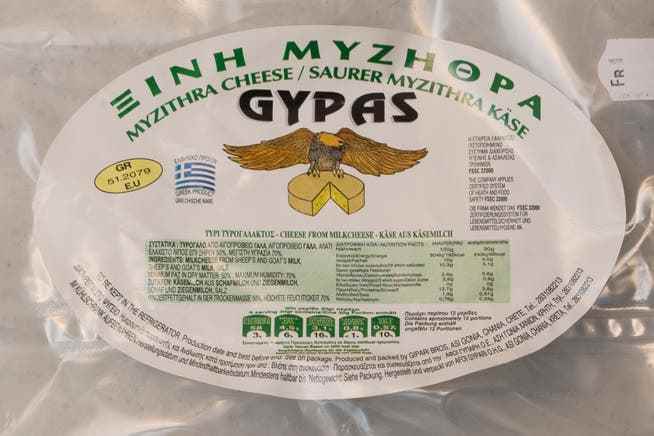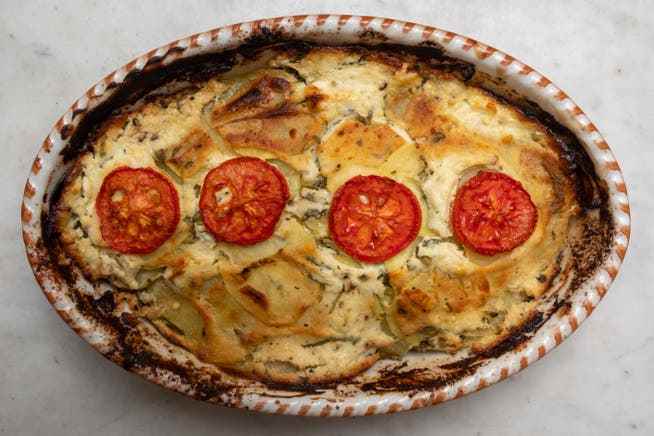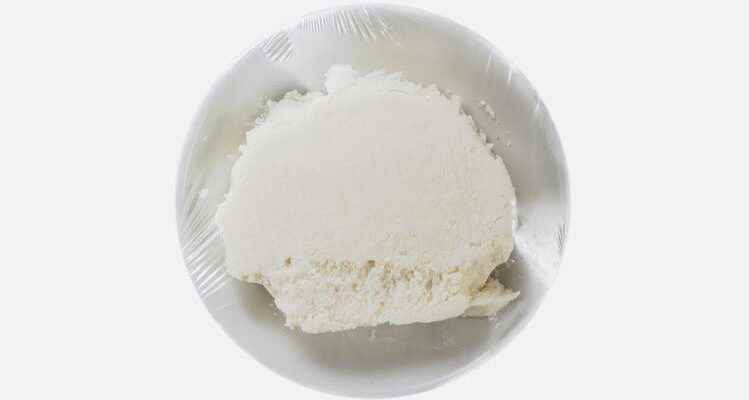On Crete, a cream cheese is made from goat’s and sheep’s whey, which tastes much more sour than feta, for example. It shapes the character of the island’s cuisine, as do the famous olive oils, herbs and wines. A recipe to cook at home.
My stomach was growling, gurgling, waking me up in the middle of the night. I had driven from Heraklion airport to Chania late the night before with nothing but a skinny sandwich in my stomach and had not found an open taverna. I pushed open the wooden shutters.
A first hint of daylight lay like mold over the old port, two fishing boats sat motionless in the mirror-smooth water. The Janissary Mosque at the other end of the quay seemed to have sunk slightly in the stony stillness of its surroundings. All cafes were still closed.
But sleep was out of the question, so I dressed warmly, left the hotel, and stumbled into the maze of alleys.
Nobody, anywhere. Again and again the bends led me back to the port, which seemed to me more and more lifeless. I thought I was caught up in a strange nightmare when a woman appeared at the other end of an alley, hurrying in the direction of Neustadt. I ran after her and after a few minutes I got to the city’s market hall, which had just opened up. The fishmongers were hoisting their wares from the ice chests onto metal tables. A butcher hung blanched tripe and calf’s feet on hooks in front of his small stall. Otherwise, most shops were still closed.
Luckily for me, however, there was a little tavern from which the steam from a coffee machine occasionally puffed into the cool air of the hall. When the patron finally found time for me, my hunger ordered almost everything he had on offer from him.
After a few snails in a musty broth, he placed a hard bun with tomato, oil and a sour cream cheese in front of me. I asked him if that was some kind of feta. He shook his head and said a complicated name that I immediately forgot.
This was followed by a herb filled pide and then a zucchini, potato and cheese casserole which, although completely cold and apparently a holdover from the previous day, was very satisfying and knocked my appetite to the ground.
I asked for the cheese again and got the convoluted word again.
The dessert was a classic: yoghurt with honey and walnuts. When the landlord then served me the coffee, I praised the firmness and fresh acidity of his yoghurt. «Yogurt? No yogurt! Cheese!’ he corrected me, and said the tricky name again. I asked him to write the word down for me, and that morning in Chania, before sunrise, I arrived at a new culinary term: xynomyzithra.
It took me all day to memorize the five syllables in the right order, and I kept having to pull the innkeeper’s faded checkered note out of my pocket.
Xynomyzithra belongs to the category of so-called whey cheeses. A wide range of such products can be found in Greece, some fresh, others eaten dried, the most famous being Anthotyro, Manouri and Myzithra.
In the production of myzithra, the whey from sheep’s and goat’s milk is heated until the curd rises to the surface. The curds are skimmed off, drained in cheesecloth and lightly salted. As it matures, the paste turns into a hard, alabaster-white ball, which is usually grated before eating.

Xynomyzithra from Chania bought in a shop called Crete in Zurich. Xynomyzithra Kritis (Ξυνομυζήθρα Κρήτης) has had a protected designation of origin since 1996.
In Crete (and some other Aegean islands) the fresh myzithra is salted, pressed and then slightly fermented. The result is a rather crumbly cheese with a wonderfully lively aroma reminiscent of baker’s yeast and a sour taste, which is where the name Xynomyzithra comes from: “sour myzithra”. On Crete it is enjoyed in a wide variety of combinations, but it is little known elsewhere.
The checkered note hung in my kitchen for many years, next to the label of a Camembert Euro-Moine. At some point the monk must have smiled at him on the ground, and then I probably sucked him away.
I only noticed its absence the moment I looked for a mouthpiece with the letter X on it and remembered my Cretan breakfast supper. However, the X was the only part of the cheese name that stuck in my head. That got me thinking. And even as I put the lost Cretan on the digital body using a search engine, I hoped that the name would come to me at the last moment.
Google was faster. Since then, I’ve been tormented by the question of how long the “cheese with X” will remain legible in the crossword puzzle of my memory this time. And I console myself with a quote that goes something like this: “We take many of our stories with us to the grave. But we leave the names behind in the world.” Or was it the other way around? It was written by an author with an S – unfortunately I forgot the rest.
Chaniótiko Bouréki

The casserole has its own distinctly sour taste, which results from the interaction of xynomyzithra and mint.
Where the Ottomans once ruled, one usually also knows Börek: cakes made of two layers of thin dough with a wide variety of fillings between them.
The Cretan variant is called Bouréki and is filled with zucchini, potatoes and sour cream cheese (xynomyzithra).
In Chania there is also a lighter version that does not require dough and is called Chaniótiko Bouréki.
For 4 people
- 400 g xynomyzithra, crumbled
- 200 grams of yoghurt
- 15 g mint, finely chopped
- 1 tsp salt
- 1 tsp black pepper, ground
- 4 tbsp olive oil
- 500 grams of courgettes
- 500 g potatoes, boiled and peeled
- 250 g tomato, thinly sliced
Mix together the cheese, yoghurt, mint, salt and pepper.
Brush the casserole dish (2 l) with olive oil. Slice half of the courgettes, then half of the potatoes into the dish. Drizzle with a little olive oil, spread half of the cheese mixture on top, place half of the tomato slices on top, drizzle with olive oil. repeat process.
Cover casserole dish with aluminum foil. Cook in a 180 degree oven for 30 minutes. Remove the aluminum foil, poke a few holes in the casserole with a sharp knife, and bake for a further 30 minutes.
